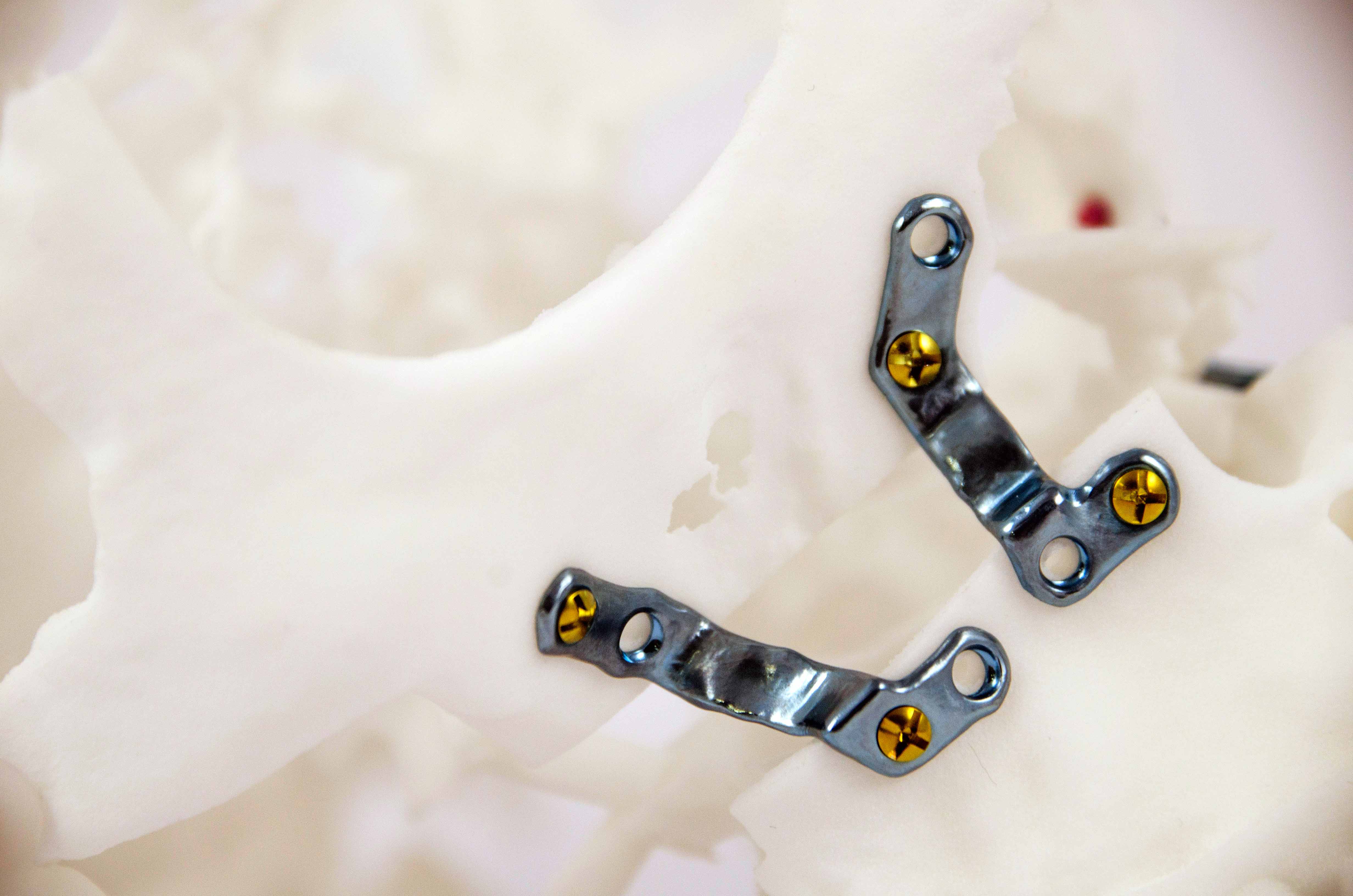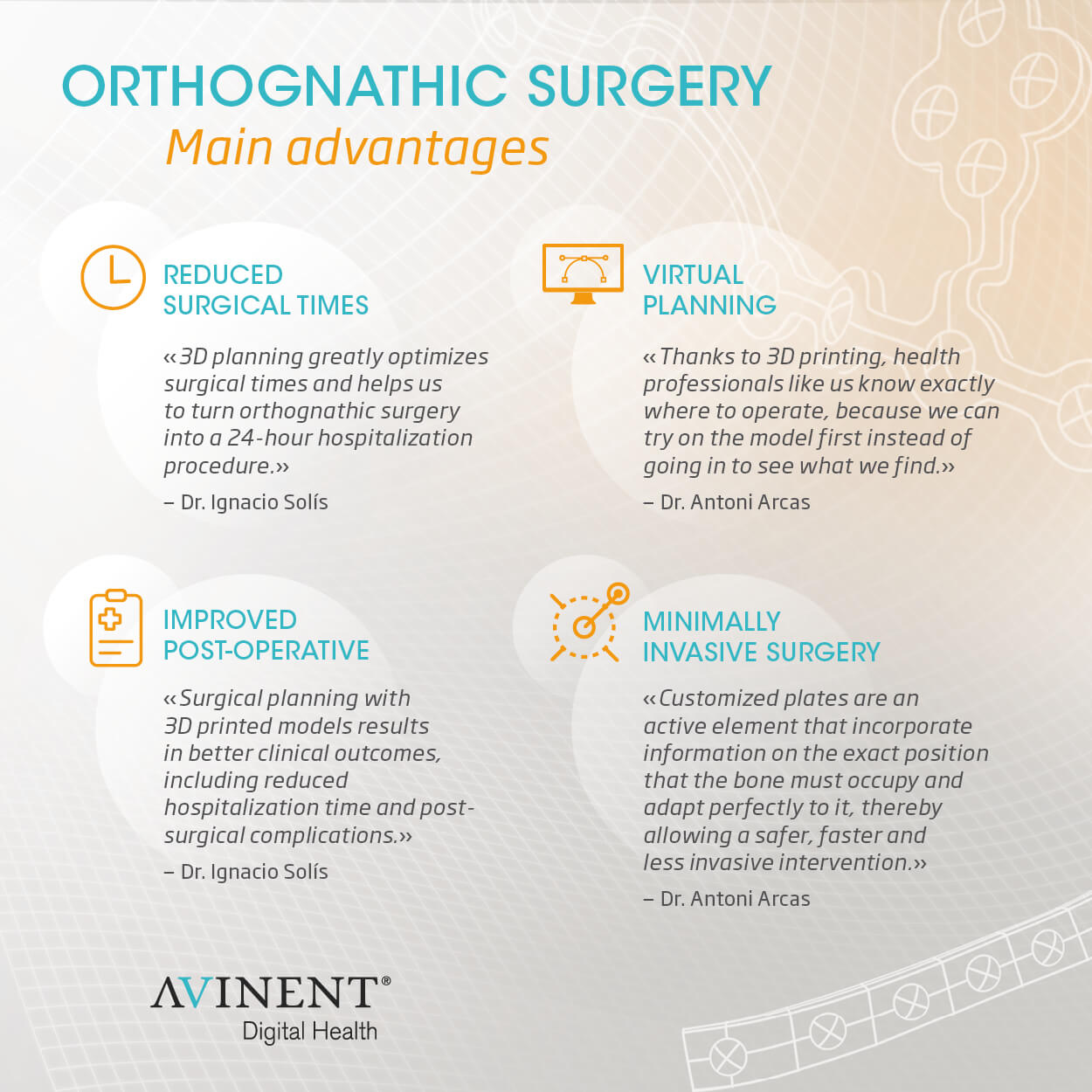

Unbeatable predictability is achieved when it comes to operations, as it allows the printing of anatomical study models for prior planning and control of the surgery.
Last week we read about how AVINENT Digital Health designs and produces all manner of plates for orthognathic surgery, as well as how 3D technology and biocompatible materials are helping to create fully customized plates that perfectly adapt to each particular case. Today, we want to explore the impact of 3D printing in the field of orthognathic surgery, so we have sought the views of two renowned surgeons who are experts in this field.
Dr. Ignacio Solís leads the maxillofacial surgery team at Hospital 9 de Octubre in Valencia and Hospital Rey Don Jaime in Castellón. An expert in orthognathic surgery, implantology and facial reconstructive surgery, he states that osteotomies (cuts in the bones) are performed in the maxillae or mandible for this type of surgery and this “allows them to be moved and then fixed in the appropriate position by using miniplates and screws”.
Dr. Antoni Arcas, a specialist in oral and maxillofacial surgery leading the team of doctors and surgeons at the Maxilodexeus Maxillofacial Clinic in Barcelona, opines in a similar vein. Dr. Arcas explains that orthognathic surgery is a very intense operation in terms of the face that helps to correct all profile disorders (prognathism, retrognathia, etc.) and others of a frontal nature (asymmetries, open bites, gingival smile). As he points out: “Our conception of orthognathic surgery takes into account an overall view of the face, so that our patients benefit from additional procedures if required, such as rhinoplasty, mentoplasty, malar implants, liposculpture, etc.”
Dr. Ignacio Solís adds that the AVINENT Digital Health system is perfect for “cases involving major movements in orthognathic surgery, such as greater mandibular or maxillary advancement”. According to Dr. Solís, the fact that the plates are cut to size “is what allows for more ambitious movements, achieving very rigid, high stability plates”.
Comprehensive planning
Alongside major investment in highly complex machinery, specialized software and a team of top-level biomedical engineers, AVINENT Digital Health has been able to design this new service thanks to the know-how it has acquired in implantology, biocompatible human body materials and digital systems.
According to Dr. Antoni Arcas, one change that surgeons have made is to use increasingly less invasive techniques, allowing much faster recovery times, with less inflammation and surgical trauma: “This change has helped patients to access treatments with faster recovery times and a quicker return to normal life,” he says. He also indicates that the most advanced, modern orthognathic surgery requires comprehensive planning that must take into account any contingencies that may occur during surgery: “AVINENT Digital Health makes it possible to convert a CT scan into a virtual model, so that surgeons can know the condition of the bone structure to be operated on before surgery takes place.”

In this way, Dr. Ignacio Solís adds, “unbeatable predictability is achieved when it comes to operations, as it allows the printing of anatomical study models for prior planning and control of the surgery”. Bone contacts can thereby be detected and osteosynthesis screws can be fixed in safe areas with good bone quality: “The mandible, maxillae, zygomatic bones, nose, orbital regions, teeth and all soft tissues covering the facial skeleton and cervical region must be thoroughly studied,” says this expert in orthognathic surgery.
Dr. Antoni Arcas fully agrees with this assessment and lists another important advantage: “3D cutting guides allow us to be remarkably precise and achieve millimeter perfect accuracy as regards the movement that the bone is going to make,” he claims. “In order to do this, a 3D scan is made and a model is created. In this way, health professionals know where to operate, because it can be virtually planned with 3D models,” explains Dr. Antoni Arcas, who also points out that 3D technology “increases procedural efficiency in terms of both economic and labor costs”.

Customization is the key to the future
Dr. Ignacio Solís is emphatic when he claims that “3D printing has opened many doors for us,” as he outlines one unprecedented change: “You can now undertake cases that until recently were unimaginable and today’s levels of precision allow us to cover an ever-increasing range of solutions.” By way of example, he points to facial asymmetries, which “we can correct safely and precisely by using three dimension”.
Dr. Antoni Arcas says that the differences between serialized and customized plates are huge: “Serialized plates are only the means to fix the bone, as they must be molded and adapted to the patient, with all the disadvantages that inaccurate artisanal work and time involved in the molding imply.” Alternatively, Dr. Arcas adds, customized plates “are an active element, as they incorporate information on the exact position that the bone must occupy and adapt perfectly to it, thereby allowing a safer, faster, less invasive operation”.

So in orthognatics today, “we always use customized plates, because the advantages they bring in terms of post-operative outcomes are much greater than conventional plates. We only use conventional plates in facial fractures where the starting point is not from the original image to be able to produce the customized plates.
Dr. Ignacio Solís agrees that this technology “implies and will imply an even greater improvement in healthcare, saving costs and reducing times in long operations”. Furthermore, he argues that the industry is moving towards “an objectification of surgical interventions, in such a way that implants can be fully adapted to the patient’s structure. It ultimately implies another step towards fully personalized medicine.”
In short, AVINENT Digital Health is leading the paradigm shift that 3D printing has brought to the field of orthognathic surgery, with a first-class digital platform and advanced design software to develop customized solutions, as well as a team of highly qualified biomedical technicians and engineers.